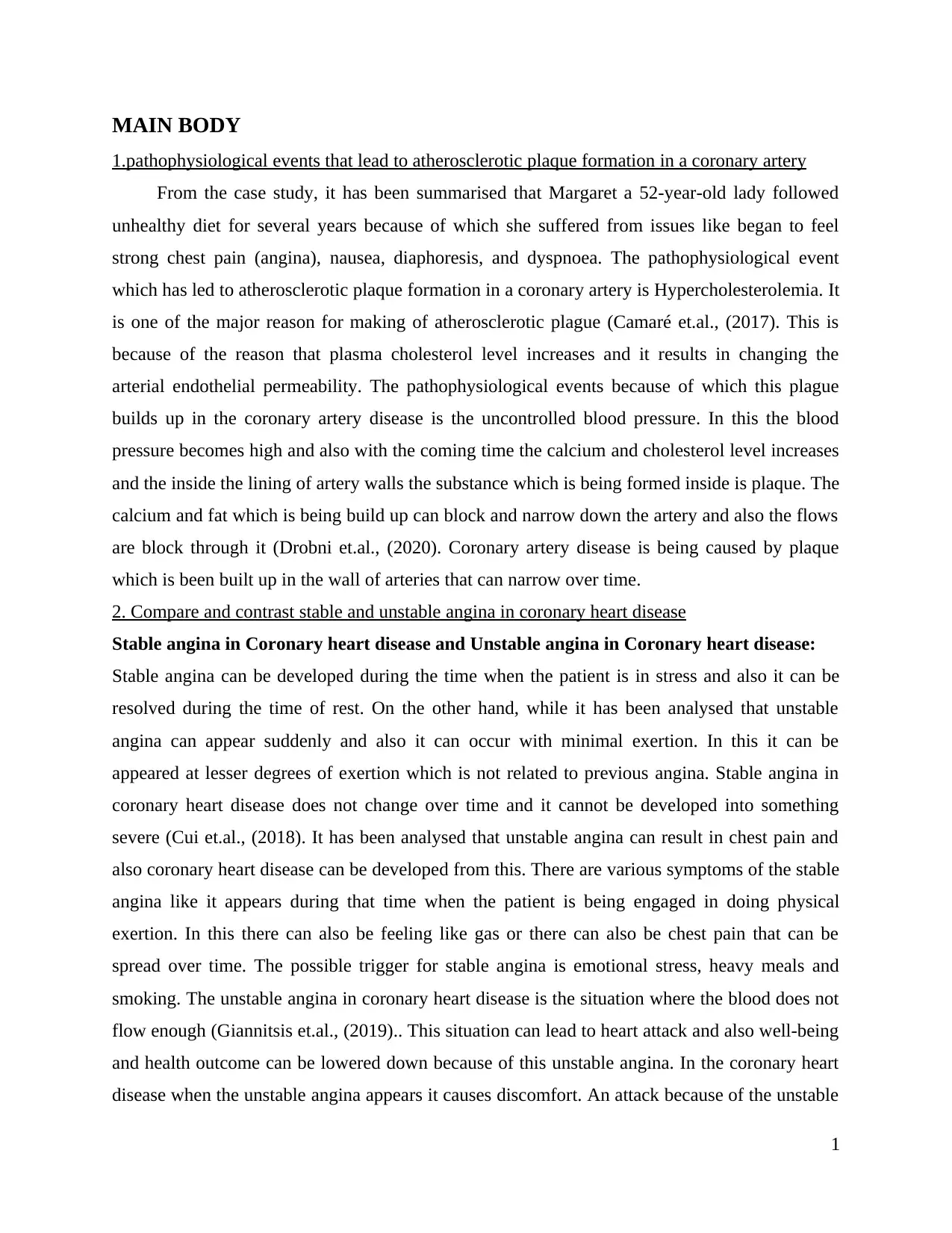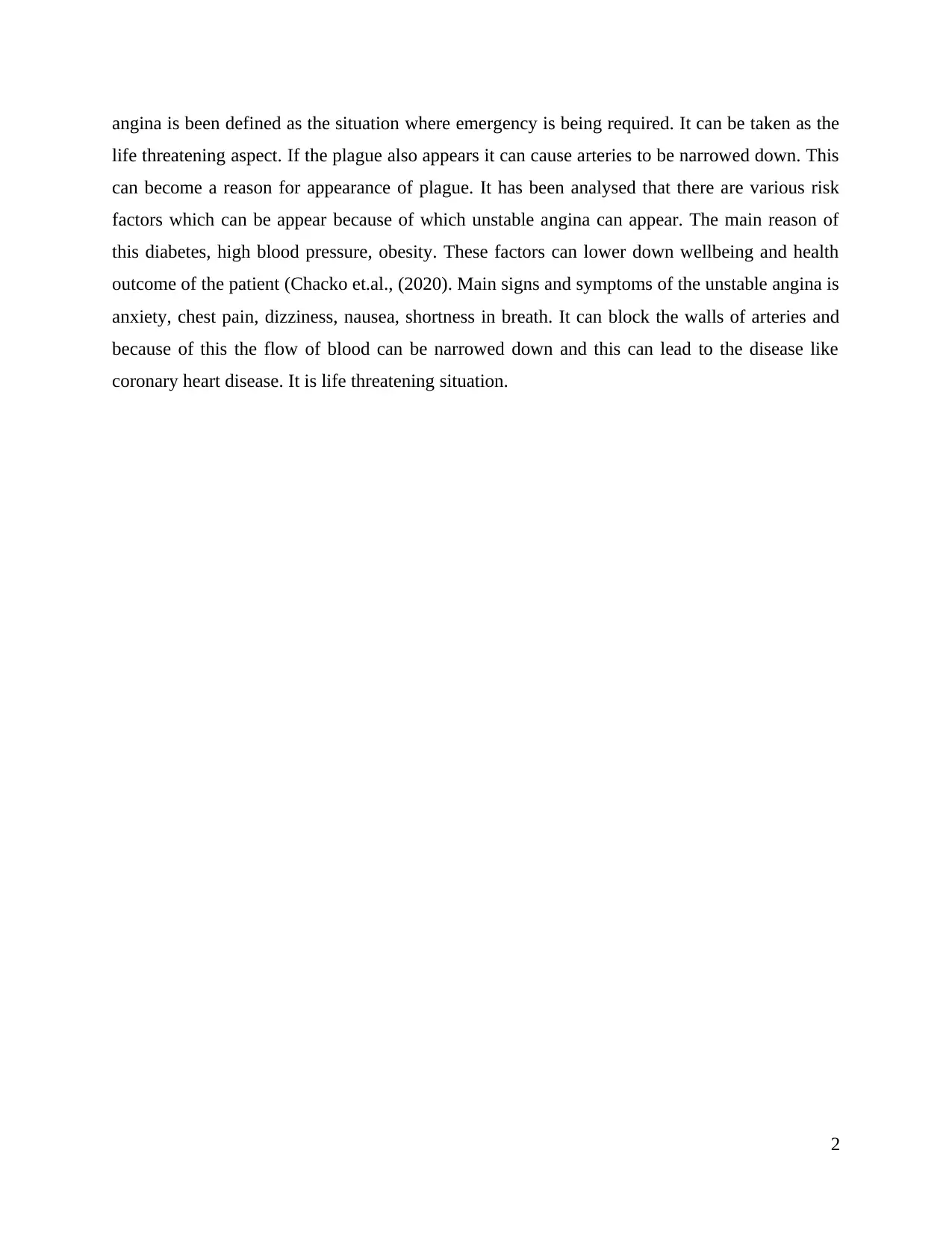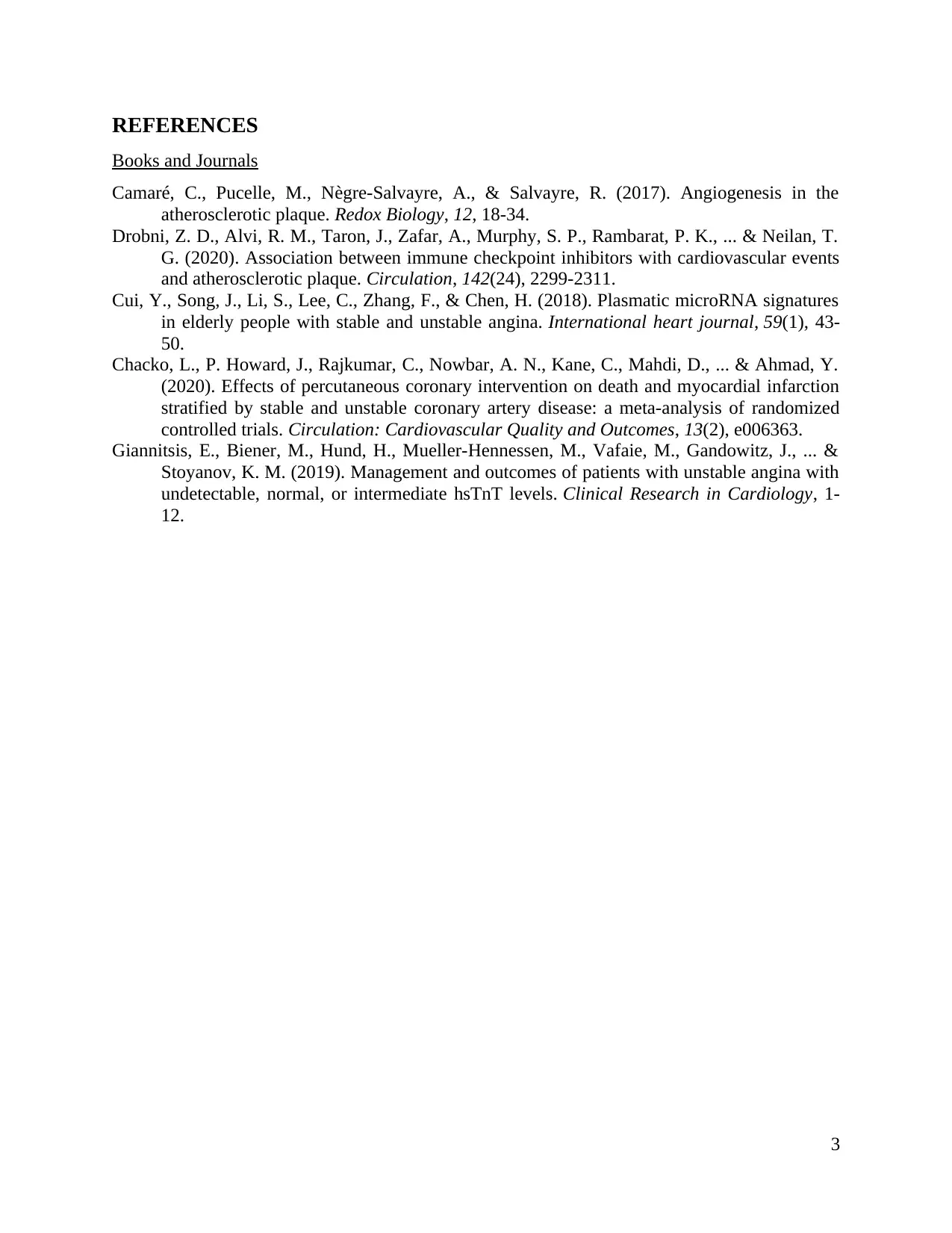Cardiovascular Dysfunction Analysis: Angina and STEMI Report
VerifiedAdded on 2022/12/27
|5
|993
|78
Report
AI Summary
This report addresses cardiovascular dysfunction, beginning with the pathophysiological events leading to atherosclerotic plaque formation in a coronary artery, specifically focusing on hypercholesterolemia and its impact. It then compares and contrasts stable and unstable angina, highlighting thei...

Cardiovascular Dysfunction
Paraphrase This Document
Need a fresh take? Get an instant paraphrase of this document with our AI Paraphraser

Contents
MAIN BODY..................................................................................................................................1
1.pathophysiological events that lead to atherosclerotic plaque formation in a coronary artery.1
2. Compare and contrast stable and unstable angina in coronary heart disease..........................1
REFERENCES................................................................................................................................3
MAIN BODY..................................................................................................................................1
1.pathophysiological events that lead to atherosclerotic plaque formation in a coronary artery.1
2. Compare and contrast stable and unstable angina in coronary heart disease..........................1
REFERENCES................................................................................................................................3

MAIN BODY
1.pathophysiological events that lead to atherosclerotic plaque formation in a coronary artery
From the case study, it has been summarised that Margaret a 52-year-old lady followed
unhealthy diet for several years because of which she suffered from issues like began to feel
strong chest pain (angina), nausea, diaphoresis, and dyspnoea. The pathophysiological event
which has led to atherosclerotic plaque formation in a coronary artery is Hypercholesterolemia. It
is one of the major reason for making of atherosclerotic plague (Camaré et.al., (2017). This is
because of the reason that plasma cholesterol level increases and it results in changing the
arterial endothelial permeability. The pathophysiological events because of which this plague
builds up in the coronary artery disease is the uncontrolled blood pressure. In this the blood
pressure becomes high and also with the coming time the calcium and cholesterol level increases
and the inside the lining of artery walls the substance which is being formed inside is plaque. The
calcium and fat which is being build up can block and narrow down the artery and also the flows
are block through it (Drobni et.al., (2020). Coronary artery disease is being caused by plaque
which is been built up in the wall of arteries that can narrow over time.
2. Compare and contrast stable and unstable angina in coronary heart disease
Stable angina in Coronary heart disease and Unstable angina in Coronary heart disease:
Stable angina can be developed during the time when the patient is in stress and also it can be
resolved during the time of rest. On the other hand, while it has been analysed that unstable
angina can appear suddenly and also it can occur with minimal exertion. In this it can be
appeared at lesser degrees of exertion which is not related to previous angina. Stable angina in
coronary heart disease does not change over time and it cannot be developed into something
severe (Cui et.al., (2018). It has been analysed that unstable angina can result in chest pain and
also coronary heart disease can be developed from this. There are various symptoms of the stable
angina like it appears during that time when the patient is being engaged in doing physical
exertion. In this there can also be feeling like gas or there can also be chest pain that can be
spread over time. The possible trigger for stable angina is emotional stress, heavy meals and
smoking. The unstable angina in coronary heart disease is the situation where the blood does not
flow enough (Giannitsis et.al., (2019).. This situation can lead to heart attack and also well-being
and health outcome can be lowered down because of this unstable angina. In the coronary heart
disease when the unstable angina appears it causes discomfort. An attack because of the unstable
1
1.pathophysiological events that lead to atherosclerotic plaque formation in a coronary artery
From the case study, it has been summarised that Margaret a 52-year-old lady followed
unhealthy diet for several years because of which she suffered from issues like began to feel
strong chest pain (angina), nausea, diaphoresis, and dyspnoea. The pathophysiological event
which has led to atherosclerotic plaque formation in a coronary artery is Hypercholesterolemia. It
is one of the major reason for making of atherosclerotic plague (Camaré et.al., (2017). This is
because of the reason that plasma cholesterol level increases and it results in changing the
arterial endothelial permeability. The pathophysiological events because of which this plague
builds up in the coronary artery disease is the uncontrolled blood pressure. In this the blood
pressure becomes high and also with the coming time the calcium and cholesterol level increases
and the inside the lining of artery walls the substance which is being formed inside is plaque. The
calcium and fat which is being build up can block and narrow down the artery and also the flows
are block through it (Drobni et.al., (2020). Coronary artery disease is being caused by plaque
which is been built up in the wall of arteries that can narrow over time.
2. Compare and contrast stable and unstable angina in coronary heart disease
Stable angina in Coronary heart disease and Unstable angina in Coronary heart disease:
Stable angina can be developed during the time when the patient is in stress and also it can be
resolved during the time of rest. On the other hand, while it has been analysed that unstable
angina can appear suddenly and also it can occur with minimal exertion. In this it can be
appeared at lesser degrees of exertion which is not related to previous angina. Stable angina in
coronary heart disease does not change over time and it cannot be developed into something
severe (Cui et.al., (2018). It has been analysed that unstable angina can result in chest pain and
also coronary heart disease can be developed from this. There are various symptoms of the stable
angina like it appears during that time when the patient is being engaged in doing physical
exertion. In this there can also be feeling like gas or there can also be chest pain that can be
spread over time. The possible trigger for stable angina is emotional stress, heavy meals and
smoking. The unstable angina in coronary heart disease is the situation where the blood does not
flow enough (Giannitsis et.al., (2019).. This situation can lead to heart attack and also well-being
and health outcome can be lowered down because of this unstable angina. In the coronary heart
disease when the unstable angina appears it causes discomfort. An attack because of the unstable
1
You're viewing a preview
Unlock full access by subscribing today!

angina is been defined as the situation where emergency is being required. It can be taken as the
life threatening aspect. If the plague also appears it can cause arteries to be narrowed down. This
can become a reason for appearance of plague. It has been analysed that there are various risk
factors which can be appear because of which unstable angina can appear. The main reason of
this diabetes, high blood pressure, obesity. These factors can lower down wellbeing and health
outcome of the patient (Chacko et.al., (2020). Main signs and symptoms of the unstable angina is
anxiety, chest pain, dizziness, nausea, shortness in breath. It can block the walls of arteries and
because of this the flow of blood can be narrowed down and this can lead to the disease like
coronary heart disease. It is life threatening situation.
2
life threatening aspect. If the plague also appears it can cause arteries to be narrowed down. This
can become a reason for appearance of plague. It has been analysed that there are various risk
factors which can be appear because of which unstable angina can appear. The main reason of
this diabetes, high blood pressure, obesity. These factors can lower down wellbeing and health
outcome of the patient (Chacko et.al., (2020). Main signs and symptoms of the unstable angina is
anxiety, chest pain, dizziness, nausea, shortness in breath. It can block the walls of arteries and
because of this the flow of blood can be narrowed down and this can lead to the disease like
coronary heart disease. It is life threatening situation.
2
Paraphrase This Document
Need a fresh take? Get an instant paraphrase of this document with our AI Paraphraser

REFERENCES
Books and Journals
Camaré, C., Pucelle, M., Nègre-Salvayre, A., & Salvayre, R. (2017). Angiogenesis in the
atherosclerotic plaque. Redox Biology, 12, 18-34.
Drobni, Z. D., Alvi, R. M., Taron, J., Zafar, A., Murphy, S. P., Rambarat, P. K., ... & Neilan, T.
G. (2020). Association between immune checkpoint inhibitors with cardiovascular events
and atherosclerotic plaque. Circulation, 142(24), 2299-2311.
Cui, Y., Song, J., Li, S., Lee, C., Zhang, F., & Chen, H. (2018). Plasmatic microRNA signatures
in elderly people with stable and unstable angina. International heart journal, 59(1), 43-
50.
Chacko, L., P. Howard, J., Rajkumar, C., Nowbar, A. N., Kane, C., Mahdi, D., ... & Ahmad, Y.
(2020). Effects of percutaneous coronary intervention on death and myocardial infarction
stratified by stable and unstable coronary artery disease: a meta-analysis of randomized
controlled trials. Circulation: Cardiovascular Quality and Outcomes, 13(2), e006363.
Giannitsis, E., Biener, M., Hund, H., Mueller-Hennessen, M., Vafaie, M., Gandowitz, J., ... &
Stoyanov, K. M. (2019). Management and outcomes of patients with unstable angina with
undetectable, normal, or intermediate hsTnT levels. Clinical Research in Cardiology, 1-
12.
3
Books and Journals
Camaré, C., Pucelle, M., Nègre-Salvayre, A., & Salvayre, R. (2017). Angiogenesis in the
atherosclerotic plaque. Redox Biology, 12, 18-34.
Drobni, Z. D., Alvi, R. M., Taron, J., Zafar, A., Murphy, S. P., Rambarat, P. K., ... & Neilan, T.
G. (2020). Association between immune checkpoint inhibitors with cardiovascular events
and atherosclerotic plaque. Circulation, 142(24), 2299-2311.
Cui, Y., Song, J., Li, S., Lee, C., Zhang, F., & Chen, H. (2018). Plasmatic microRNA signatures
in elderly people with stable and unstable angina. International heart journal, 59(1), 43-
50.
Chacko, L., P. Howard, J., Rajkumar, C., Nowbar, A. N., Kane, C., Mahdi, D., ... & Ahmad, Y.
(2020). Effects of percutaneous coronary intervention on death and myocardial infarction
stratified by stable and unstable coronary artery disease: a meta-analysis of randomized
controlled trials. Circulation: Cardiovascular Quality and Outcomes, 13(2), e006363.
Giannitsis, E., Biener, M., Hund, H., Mueller-Hennessen, M., Vafaie, M., Gandowitz, J., ... &
Stoyanov, K. M. (2019). Management and outcomes of patients with unstable angina with
undetectable, normal, or intermediate hsTnT levels. Clinical Research in Cardiology, 1-
12.
3
1 out of 5
Related Documents
Your All-in-One AI-Powered Toolkit for Academic Success.
+13062052269
info@desklib.com
Available 24*7 on WhatsApp / Email
![[object Object]](/_next/static/media/star-bottom.7253800d.svg)
Unlock your academic potential
© 2024 | Zucol Services PVT LTD | All rights reserved.





